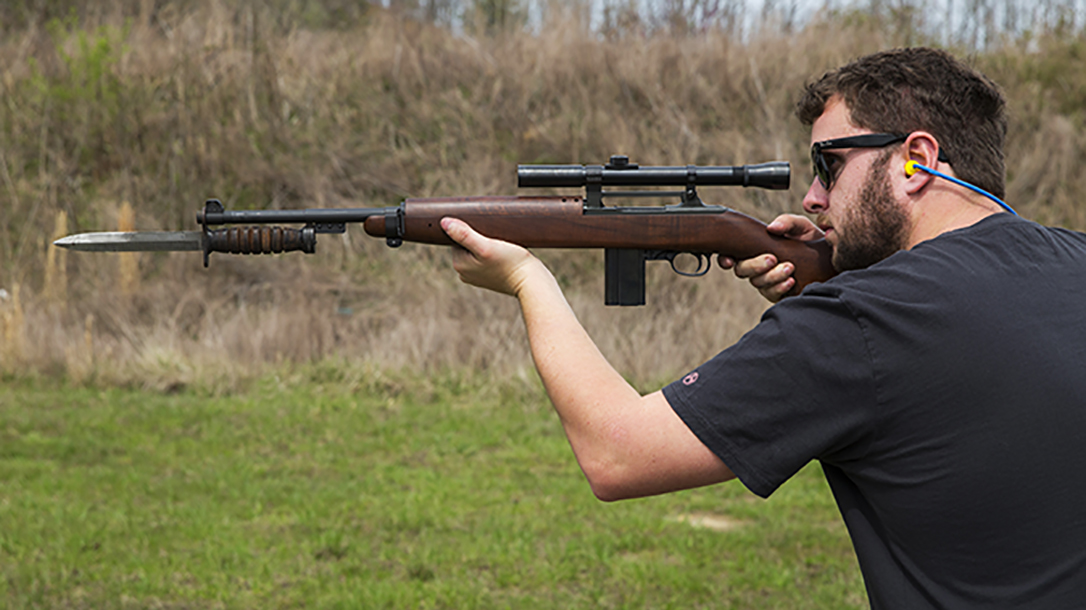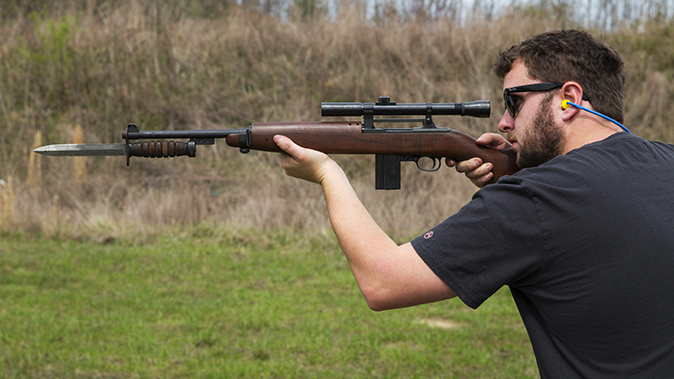Necessity, as they say, is the mother of invention. This adage is true in the military, especially during wartime. Soldiers often encounter problems or obstacles that require innovation to help them succeed. Whether it’s aircraft, tanks or the ubiquitous serviceman’s rifle, advances in fighting technology have been a stalwart part of our military’s history.
The Model 1911 service pistol, with its .45 ACP round, was developed for improved performance over .38-caliber revolvers during World War I. Likewise, another weapon was fashioned at the request of soldiers whose performance was sometimes hindered by the relatively large M1 Garand. Thus, the M1 Carbine was born. To amplify the significance of that tool, Inland Manufacturing recently introduced its new T30 carbine, which is based on the original M3/T3 Carbine from the mid-20th century.
Baptism By Fire
As soldiers gained battle experience with the M1 Garand, it became apparent that it wasn’t ideal for some segments of the United States Army. For example, people who had to carry and support heavier equipment, such as radiomen and mortar men, had difficulty carrying the M1 Garand and their equipment because of the weight. Additionally, slinging an M1 Garand across your back prevented you from carrying other equipment in similar fashion.
Advertisement — Continue Reading Below
A request was submitted to create a lighter carbine support personnel could carry with other equipment. Without going into specifics, the M1 Carbine was significantly smaller and lighter than the M1 Garand and fit the military’s needs nicely.
The M1 Carbine soon found favor with other groups on or near the front lines because of its small size, light weight and lighter .30-caliber ammunition, which allowed soldiers to carry more rounds. Paratroopers, officers and ammunition bearers were among those who used the M1 Carbine because of its increased accuracy and penetration over Model 1911 pistols.
Advertisement — Continue Reading Below
The M1 Carbine was a hit among military personnel and was used with great effect during World War II, the Korean War and even the Vietnam War. Of course, the latter two are often described as “conflicts” or “police actions,” but in my opinion, when American personnel put their lives at risk while engaging any enemy, it’s war.
Because of the M1 Carbine’s popularity, and to serve other requirements, other variants were produced, including the select-fire M2, for use as a submachine gun, and the M3, which was designed to be more of a sniper’s rifle.
M3 Carbine
The M3 Carbine, also called the T3, was developed to serve a unique role for troops, and it was an example of cutting-edge technology. The T3 was actually a system rather than just a rifle. Fitted with a permanent scope base in lieu of standard sights, the M3’s infrared sniper scope let personnel see the enemy at night.
Advertisement — Continue Reading Below
First deployed in Okinawa, the T3 consisted of a large battery pack, a spotlight and the scope, and the package generally required two to three personnel to support the system. Like the M2, the M3 was a select-fire model, but it was designed to let American personnel watch enemy troop movements at night. Though the practical effective range of the carbine was 200 meters, it was restricted to about 70 yards at night because of the infrared scope’s power limitations.
The new Inland T30 model, has mostly replicated that design, including attributes from the original M3. It has a permanently attached scope base that is welded to the receiver, plus a conical flash suppressor and a bayonet lug to accept the M4 bayonet.
Additionally, the Inland T30 uses a period-correct 2.5x M82G2 scope from Hi-Lux Optics that uses Redfield-style scope rings. Though it lacks the infrared system of the original M3, Inland’s T30 is a faithful representation of the style of rifle and accoutrements used during the times.
Advertisement — Continue Reading Below
Inland’s Modern Take
The sample rifle I received for testing from Inland had a clean design and sported an excellent fit and finish overall. There was no slop or play in the parts, and straight from the box, the Inland T30 looked like it had been put together well. Accessories included a sling, the conical flash suppressor, the M82G2 scope and a 15-round magazine—everything needed to take a step back in time to get a feel for what some troops experienced.
Mounting the scope was simple, as the base of the front ring fits into a slot at the front of the scope base. By twisting the scope into proper position, the front ring locks into place. The removable screws on the rear of the base let the post on the rear ring fit between the two screws for a snug fit and gross windage adjustments.
The stock is fashioned from walnut, yet the carbine weighs just 5.3 pounds, making it incredibly nimble. With the scope, the T30 weighs 6 pounds. It has an18-inch barrel.
Advertisement — Continue Reading Below
Although the riflescope’s vintage appearance replicates the original, Hi-Lux Optics has made some improvements. Thanks to modern coatings and excellent light transmission, the image quality of the scope is excellent despite its rather small 0.875-inch tube diameter.
In fact, although it’s a 2.5X scope, the image quality at 100 yards is fantastic—a significant factor in the results I achieved at the range. Exceeding the original, the High-Lux M82G2 offers 80 MOA of adjustment for windage and elevation.
Going Back In Time
To add a realism and nostalgia to one of the testing sessions, I brought a friend with two original Inland M1 Carbines made in 1944. He also brought an M4 bayonet and some surplus ammunition to go with the ammunition I had on hand.
Advertisement — Continue Reading Below
For testing, I had Federal’s 110-grain American Eagle FMJs as well as the company’s 110-grain Power-Shok ammunition. I also included Hornady’s excellent 110-grain Critical Defense FTX load. Despite the M1 Carbine’s popularity, I was surprised by the lack of ammunition variety, but the three loads I had covered my needs.
After fitting the conical suppressor on the barrel and doing some comparisons between the rifles, we played with the T30 by mounting the bayonet to check its fit, and then started shooting off-hand to get a feel for the rifle. Despite having lubed the rifle before heading to the range, the action felt stiff and gritty, though it worked itself out later.
Advertisement — Continue Reading Below
During the first day’s session, we experienced several malfunctions with every brand of ammunition. Those were mainly failures to feed, though a few stovepipes occurred, too. Even so, the action seemed to smooth up the more we fired the carbine. We stopped after a couple of hours, and I took the gun home to clean and lubricate it again.
During the next trip, things flipped, and we experienced no failures of any kind with any of the ammunition. There were no failures during the third session, either. It seems a break-in period was required to get things rolling smoothly with the T30. But after it hit its stride, there were no problems.
The rifle was extremely fun to shoot, and long-distance shots were easy with the 2.5X Hi-Lux scope. Then it was time to do some bench testing and see what the Inland T30 was capable of. M1 Carbines were never tack drivers. They generally printed 3- to 6-MOA group at 100 yards, and that was deemed close enough for government work. However, Inland Manufacturing promised better groups with its new iteration.
Advertisement — Continue Reading Below
Shooting the Inland T30 as it was intended, with the conical flash suppressor, the results weren’t too bad. The average group size for the Federal Power-Shok and Hornady Critical Defense rounds were within hundredths of an inch of each other. The Power-Shok load provided an average group size of 2.65 inches at 100 yards, and the Critical Defense rounds squeezed in at 2.62 inches. The best five-shot group was 1.94 inches with Federal’s Power-Shok load.
Remember, we shot the groups at 100 yards with a weight hanging off the barrel and with a 2.5X scope. That got me thinking. I decided to shoot some groups without the flash suppressor, and they tightened up quite a bit, with the best at just 1.26 inches, again with the Power-Shok load. I was pretty amazed at those results, and hopefully, the same holds true for all T30 carbines.
Owning History
Not all of us have the money to purchase high-quality collectibles such as the rare M3/T3 models, of which only about 2,000 were made. We have to read about such firearms rather than experience them. However, Inland Manufacturing has provided the next best thing by offering a close replica of the original M3/T3 carbine, sans the infrared scope and power pack.
The Inland T30 Carbine’s MSRP is $1,279. If you want the scope, that package is $1,695. Because of the type of scope base mounted to the receiver, it’s probably wise to go with the latter package, unless you have a scope that will work with the Redfield rings.
If you want a shooter, or you’re a fan of collectible historic firearms but can’t afford one, the new Inland T30 Carbine might be the ticket. It’s accurate and fun, and it’s something you can keep as a symbol of our heritage and those who gave the full measure of devotion to protect it.
Inland T30 Specs
| Caliber: .30 Carbine |
| Barrel: 18 inches |
| OA Length: 35.75 inches |
| Weight: 5.3 pounds (empty) |
| Stocks: Walnut |
| Sights: Front post, Hi-Lux M82G2 |
| Action: Semi-auto |
| Finish: Parkerized |
| Capacity: 15+1 |
| MSRP: $1,279-$1,695 |
Inland T30 Performance
| Load | Velocity | Accuracy |
|---|---|---|
| Federal 110 Power-Shok | 1,939 | 1.94 |
| Federal American Eagle 110 FMJ | 1,973 | 2.56 |
| Hornady 110 Critical Defense FTX | 2,003 | 2.18 |
Bullet weight measured in grains, velocity in fps by chronograph and accuracy in inches for best five-shot groups at 100 yards.
For more information, visit inland-mfg.com.




































